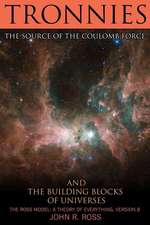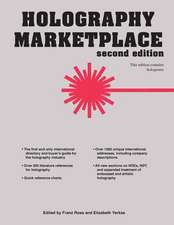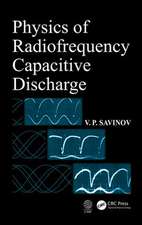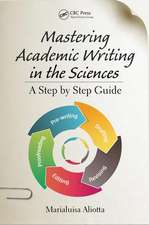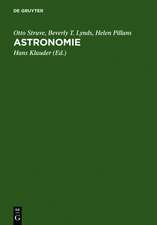Introduction to Python for Science and Engineering: Series in Computational Physics
Autor David J. Pineen Limba Engleză Paperback – 5 dec 2018
Steven A. Gottlieb and Rubin H. Landau, Series Editors
Introduction to Python for Science and Engineering
This guide offers a quick and incisive introduction to Python programming for anyone. The author has carefully developed a concise approach to using Python in any discipline of science and engineering, with plenty of examples, practical hints, and insider tips.
Readers will see why Python is such a widely appealing program, and learn the basics of syntax, data structures, input and output, plotting, conditionals and loops, user-defined functions, curve fitting, numerical routines, animation, and visualization. The author teaches by example and assumes no programming background for the reader.
David J. Pine is the Silver Professor and Professor of Physics at New York University, and Chair of the Department of Chemical and Biomolecular Engineering at the NYU Tandon School of Engineering. He is an elected fellow of the American Physical Society and American Association for the Advancement of Science (AAAS), and is a Guggenheim Fellow.
| Toate formatele și edițiile | Preț | Express |
|---|---|---|
| Paperback (2) | 365.57 lei 3-5 săpt. | +26.60 lei 10-14 zile |
| CRC Press – 5 dec 2018 | 365.57 lei 3-5 săpt. | +26.60 lei 10-14 zile |
| CRC Press – 23 sep 2024 | 380.21 lei 6-8 săpt. | |
| Hardback (2) | 947.77 lei 6-8 săpt. | |
| CRC Press – 4 dec 2018 | 1281.22 lei 3-5 săpt. | |
| CRC Press – 23 sep 2024 | 947.77 lei 6-8 săpt. |
Preț: 365.57 lei
Preț vechi: 456.96 lei
-20% Nou
Puncte Express: 548
Preț estimativ în valută:
69.96€ • 72.60$ • 58.47£
69.96€ • 72.60$ • 58.47£
Carte disponibilă
Livrare economică 22 februarie-08 martie
Livrare express 11-15 februarie pentru 36.59 lei
Preluare comenzi: 021 569.72.76
Specificații
ISBN-13: 9781138583894
ISBN-10: 1138583898
Pagini: 388
Ilustrații: 12 Tables, black and white; 59 Line drawings, black and white; 15 Halftones, black and white; 75 Illustrations, black and white
Dimensiuni: 156 x 234 x 22 mm
Greutate: 0.68 kg
Ediția:1
Editura: CRC Press
Colecția CRC Press
Seria Series in Computational Physics
ISBN-10: 1138583898
Pagini: 388
Ilustrații: 12 Tables, black and white; 59 Line drawings, black and white; 15 Halftones, black and white; 75 Illustrations, black and white
Dimensiuni: 156 x 234 x 22 mm
Greutate: 0.68 kg
Ediția:1
Editura: CRC Press
Colecția CRC Press
Seria Series in Computational Physics
Public țintă
Academic, Professional, Professional Practice & Development, and UndergraduateCuprins
1. Introduction. 2. Launching Python. 3. Strings, Lists, Arrays, and Dictionaries. 4. Input and Output. 5. Conditionals and Loops. 6. Plotting 7. Functions. 8. Curve Fitting. 9. Numerical Routines: SciPy and NumPy. 10. Data Manipulation and Analysis: Pandas. 11. Animation. 12. Python Classes & GUIs Appendix A. Installing Python. Appendix B. Jupyter notebooks. Appendix C. Glossary Appendix D. Python Resources.
Notă biografică
David J. Pine is the Silver Professor and Professor of Physics at New York University, as well as Chair of the Department of Chemical and Biomolecular Engineering at the NYU Tandon School of Engineering. He earned his PhD in physics from Cornell University and has been invited professor at ESPCI in Paris, France, and the University of Strasbourg. He has also served as a visiting scientist at Exxon Research and Engineering. He is recipient of numerous honors, including Fellow of the American Association for the Advancement of Science, Guggenheim Fellow, and Fellow of the American Physical Society.
Recenzii
"A comprehensive introduction and a practical guide to the Python programming language for scientists and engineers. Chapters intuitively introduce programming concepts around scientific problems. This approach resonates with scientists and engineers and helps them understand programming paradigms faster." --Ana Bell, PhD, Electrical Engineering and Computer Science, Massachusetts Institute of Technology
Descriere
This guide offers a rapid introduction to Python programming to anyone with no experience in programming, taking a careful and methodical approach to presenting the features available and their use for performing practical scientific and engineering tasks.





